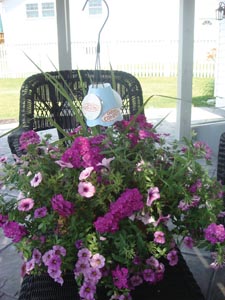12/15/2008
Production Using Confetti Liners
P. Allen Hammer

The Confetti liner (U.S. Utility Patent pending), created by the Dümmen USA team, consists of two or three cuttings from one or multiple plant genera rooted together in one 40-mm Ellepot. The liner comes in trays of 50 and in combinations of calibrachoas, petunias and verbenas, all of which match in color, timing and vigor. These liners are pinched and pre-conditioned to produce a well-branched and bushy finished habit.
The following are recommendations for successful crop production using Confetti liners.
Containers. Use a 5-in. pot with one liner per pot or a 10- or 12-in. hanging basket with three to four liners per pot.
Crop time. Crop time will take six to eight weeks in early spring. Production time will be reduced with higher light levels and improved growing environments.
Potting. Liners should be potted in a root medium with a pH of 5.5 to 6.2 at the same depth of the liner. Single liners should be placed in the center of the container. If using multiple liners, arrange them in the container equidistantly from the edge and center of the container.
Light and temperature. All liner combinations should be grown in high light for best and most rapid growth. A 75F (24C) day and 65F (18C) night temperature regimen is recommended for maximum growth. Plants grown at 5- to 10-degree cooler temperatures will have better plant form. However, this will add significant time to the production schedule.
Fertilizer application. High fertilization creates a nice bushy growth habit. Start with 1.5 EC (SME) and increase up to 2.8 EC (SME) during production. Use a complete NPK fertilizer such as 20-10-20.
Additional chelated iron applications may be required to prevent upper leaf yellowing of calibrachoa and petunia combinations. The newer formulation of petunia/calibrachoa fertilizer can also be used to avoid pH problems. Growers should monitor root medium pH and maintain it below 6.0 to prevent chlorosis.
Plant growth regulator applications. Apply PGRs when new growth starts, usually one to two weeks after planting. PGR applications will vary among combinations and growing conditions. Cooler growing conditions (less than 65F or 18C) require less PGR. Early application of a PGR should not be applied to the Potunia combinations.
Suggested PGR concentrations:
• B-Nine or Dazide (daminozide): 2,500 ppm
• Mix of Cycocel or Citadel (chlormequat chloride)/ B-Nine or Dazide (daminozide): 750/1,500 ppm
• Bonzi, Paczol, or Piccolo (paclobutrazol): 5 to 45 ppm
• Topflor (flurprimidol): 15 to 60 ppm
Pinching. Additional pinching during growth is not required but greatly improves branching and plant form, particularly for combinations containing verbenas.
Late PGR application. A late drench of 1 ppm Bonzi, Paczol or Piccolo (paclobutrazol) when the plant has reached saleable size can be used to improve plant form. Use drench volumes that are appropriate for the plant’s container size.
Confetti liners are available exclusively through Ball.
P. Allen Hammer is a retired professor of floriculture at Purdue University and now works in product development and support for Dummen USA.